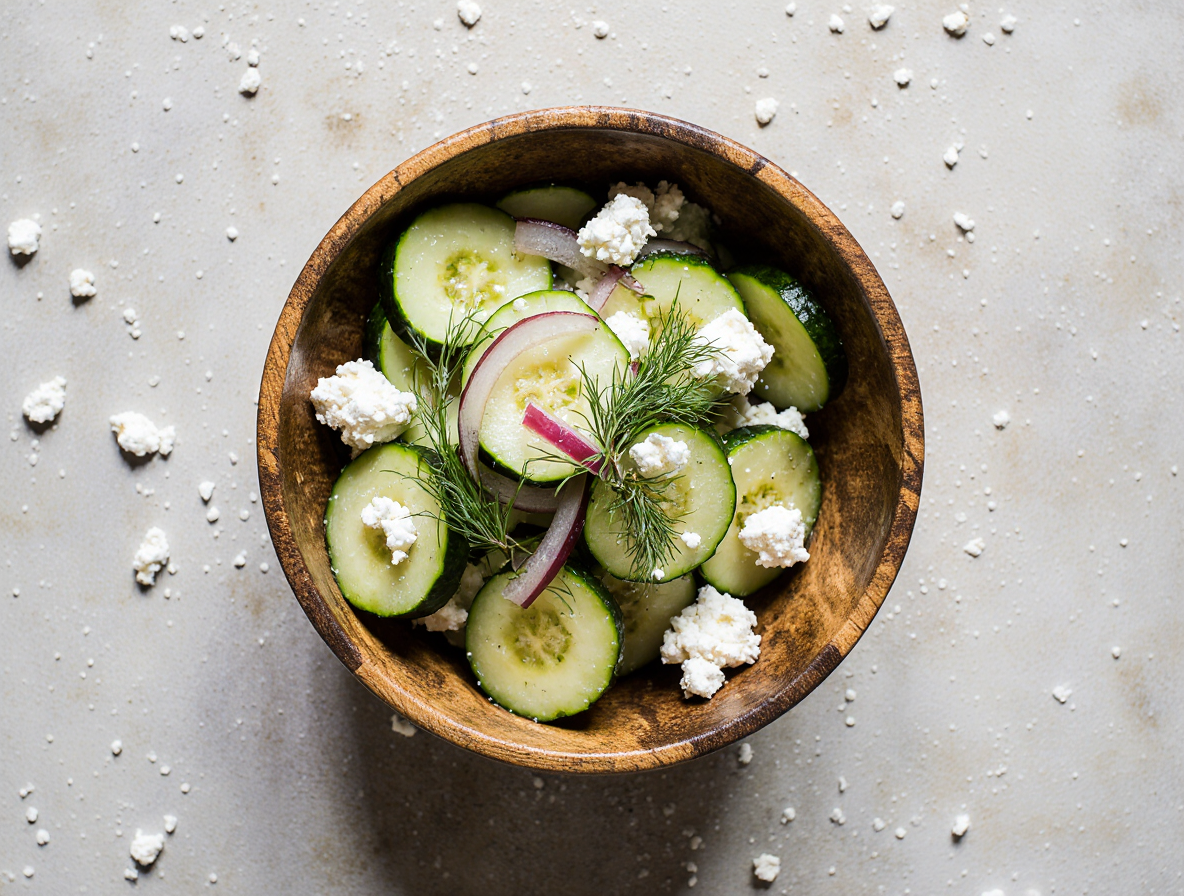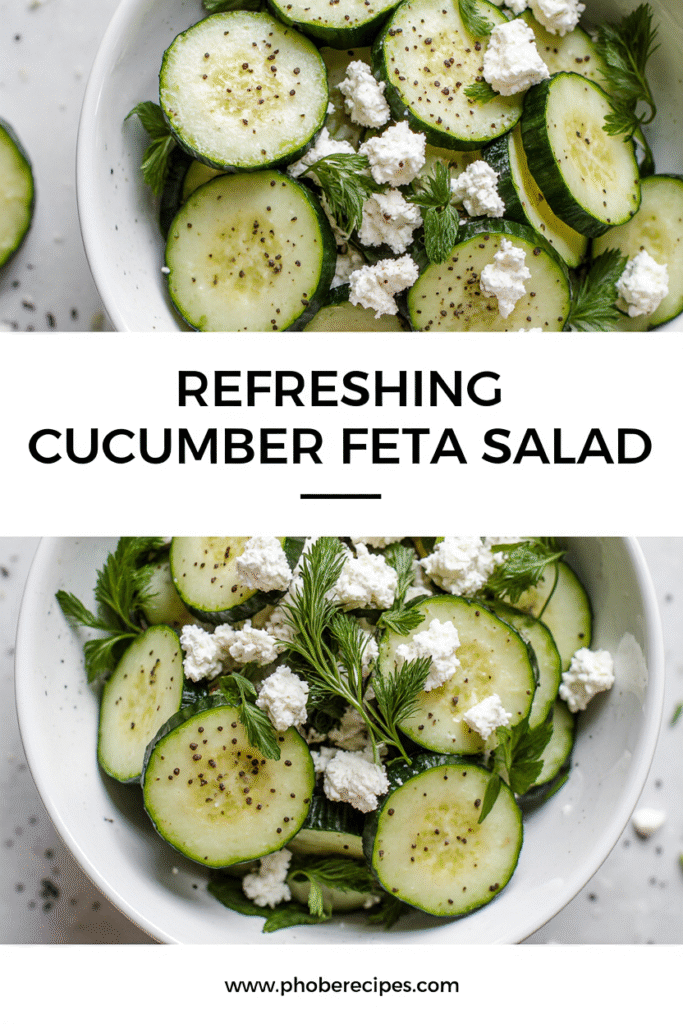The Secret to Making the Best Cucumber Feta Salad (Tested by a Chef)
Cucumber and feta salad appears on our dinner table at least four nights a week. This refreshing combination has quickly become my go-to side dish when I want something versatile that pairs perfectly with almost any meal.
This light, flavorful Greek salad combines juicy tomatoes, crisp cucumbers, creamy feta cheese, and fragrant herbs. What I love most about this cucumber salad with feta cheese is the perfect balance of textures and flavors—it’s fresh, salty, tangy, and bright with a wonderful mix of crispy, crunchy, soft, and tender bites. Additionally, it works beautifully as both a side dish for Mediterranean dinners or as a topping for steak, chicken, or fish.
In this guide, I’ll share everything I’ve learned about creating the perfect cucumber feta cheese salad. From selecting the best ingredients (specifically why block feta is far superior to pre-crumbled varieties) to proper preparation techniques and storage tips. I’ll also offer several variations so you can customize this classic dish to your preferences.
Essential Ingredients for the Perfect Cucumber Feta Salad
Creating the perfect cucumber and feta salad starts with selecting quality ingredients. The right combination of crisp vegetables, creamy cheese, fresh herbs, and balanced dressing makes all the difference in this refreshing dish.
Choosing the right cucumber: English vs. Persian
For cucumber feta cheese salad, two varieties stand out above regular slicing cucumbers. English cucumbers measure approximately 12 inches long, while Persian cucumbers are smaller at just 4-6 inches. Both share important qualities that make them ideal for salads: thin, edible skin; tiny, barely noticeable seeds; and a refreshingly sweet flavor.
Persian cucumbers offer a crispier bite and slightly sweeter taste than their English cousins. Furthermore, they’re perfect for salads due to their crunch and less watery texture. English cucumbers, however, excel when you need larger slices or a slightly milder flavor.
At the grocery store, English cucumbers typically come individually wrapped in plastic, while Persian cucumbers are sold in packs of five or six. Neither requires peeling or seeding—a significant time-saver during preparation.
Why block feta is better than crumbled
When making cucumber salad with feta cheese, always choose block feta over pre-crumbled varieties. Crumbled feta usually contains powdered cellulose or other anti-caking agents that make it taste dry and hard. Block feta offers superior texture and longer shelf life.
Ideally, purchase feta in brine, which protects the cheese from air exposure that can dry it out and cause a sour taste. Stored properly in brine, feta remains moist and fresh for up to three months. The brine also contributes to feta’s characteristic tangy, salty flavor.
Authentic Greek feta has a delightfully soft, crumbly texture and becomes saltier and sharper with age. For the best cucumber feta salad recipe, look for block feta sold in brine rather than pre-crumbled options.
Fresh herbs that elevate flavor
Fresh herbs are essential for adding brightness and depth to any greek cucumber salad. Mint and dill create a classic pairing that brings freshness and flavor. Other excellent options include parsley, basil, chives, and oregano.
These aromatic additions complement the crisp cucumber and tangy feta perfectly, creating a more complex and satisfying dish.
Oil, vinegar, and acid: balancing the dressing
The traditional vinaigrette ratio is 3:1—three parts oil to one part acid. Nevertheless, some prefer a sharper 2:1 ratio for a brighter, more flavorful dressing.
For proper emulsification, always start with vinegar in your bowl before adding oil. Ingredients like mustard, sugar, salt, or honey dissolve better in vinegar than oil. Emulsifiers such as mustard, honey, garlic, or egg yolk help keep oil and vinegar from separating.
A well-balanced dressing ensures each bite of cucumber and feta cheese salad is perfectly coated. Store any leftover dressing in a glass jar with a tight-fitting lid for up to two weeks.
Step-by-Step Guide to Making Cucumber Feta Salad
Making a delicious cucumber and feta salad requires minimal effort yet delivers maximum flavor. The process consists of four simple steps that transform basic ingredients into a refreshing dish.
1. Prepping the vegetables
The goal with cucumber feta cheese salad is to have all components approximately the same size. Begin by thinly slicing your cucumbers—the thinner, the better for a delicate texture. If preparing the salad in advance, consider removing the seeds, though this isn’t necessary for immediate consumption.
For tomatoes, dice them into bite-sized pieces or halve cherry tomatoes. If including red onion, slice it thinly to prevent overwhelming the salad. Moreover, finely chop herbs like parsley, dill, or basil to distribute their flavor evenly throughout the dish.
2. Mixing the dressing
In a small bowl, whisk together olive oil, an acid (lemon juice or vinegar), and seasonings until well combined. Alternatively, place all dressing ingredients in a mason jar and shake vigorously—this method creates a perfectly emulsified dressing.
For a classic dressing, combine olive oil, red wine vinegar, minced garlic, oregano, salt, and pepper. Mustard can be added as an emulsifier to prevent separation. Consequently, your dressing should be well-balanced to coat each ingredient without overpowering the natural flavors.
3. Combining and tossing
Place all prepped vegetables, herbs, and crumbled feta in a large mixing bowl. Drizzle the dressing over the ingredients gradually, as you can always add more. Subsequently, use tongs or clean hands to gently toss everything together until well combined.
For presentation purposes, consider leaving some feta crumbles on top rather than mixing them completely. This creates an appetizing visual contrast against the colorful vegetables.
4. Letting it rest for flavor infusion
For optimal flavor development, allow your cucumber feta salad to rest for 10-15 minutes before serving. This brief resting period enables the vegetables to absorb the dressing while still maintaining their crispness. Afterward, your salad will have developed a harmonious blend of flavors, ready to be enjoyed as a side dish or light meal.
Tips and Variations to Customize Your Salad
The beauty of a cucumber and feta salad lies in its versatility. Over years of making this Mediterranean classic, I’ve discovered countless ways to customize it based on what’s in my refrigerator or garden.
Add-ins: avocado, olives, red onion, or chickpeas
Transforming your basic cucumber and feta cheese salad is simple with these flavorful add-ins:
- Avocado: Adds creamy texture and healthy fats that complement the crispness of cucumbers
- Kalamata olives: Provide a salty, briny flavor that enhances the Mediterranean profile
- Red onion: Offers a sharp contrast that works exceptionally well with fresh vegetables
- Chickpeas: Turn your side dish into a protein-packed meal while maintaining the salad’s integrity
Beyond these classics, consider adding cherry tomatoes, bell peppers, or even white beans for additional texture and nutrition.
Herb swaps: dill, mint, parsley, or basil
Fresh herbs are the secret to elevating any greek cucumber salad. In particular, dill creates a classic flavor profile, but don’t hesitate to experiment. Mint adds unexpected freshness, especially in summer. Alternatively, basil offers a sweet aromatic quality, whereas parsley provides a clean, bright taste. For something different, try cilantro or even a pinch of fresh oregano.
Dressing alternatives: lemon juice, balsamic, or yogurt-based
The traditional olive oil and red wine vinegar dressing is just the beginning. For instance, balsamic vinegar creates a sweeter profile, whereas fresh lemon juice brightens the entire dish. Of course, for a creamier variation, try a yogurt-based dressing that adds richness without heaviness. A tahini-based option likewise brings nutty depth to your cucumber feta cheese salad.
Making it a meal: add grilled chicken or salmon
Turn your cucumber and feta salad into a complete meal by adding:
- Grilled chicken breast for lean protein
- Salmon filets for omega-rich satisfaction
- Grilled steak for heartier appetites
- Cooked shrimp for a seafood twist
First and foremost, when adding protein, consider increasing your dressing quantity to maintain proper flavor balance.
Storage, Make-Ahead, and Serving Ideas
Fresh is best when it comes to cucumber and feta salad, yet understanding proper storage techniques can help maintain its vibrant flavors even after preparation.
How to store leftovers without losing crunch
Cucumber and feta cheese salad keeps best in airtight containers in the refrigerator. Storage times vary significantly based on ingredients – simple versions last 1-2 days, while some recipes claim up to 5 days. In reality, cucumbers naturally lose their crispness over time, typically becoming softer after the first day.
For maintaining maximum crunch, consider these tips:
- Remove seeds from cucumbers if storing longer than a day
- Keep herbs, particularly cilantro, separate until serving
- Store in glass containers rather than plastic for better texture preservation
Can you make it ahead of time?
Yes! The key to successful make-ahead cucumber feta salad lies in component separation. Certainly, you can prepare ingredients up to a day in advance, storing vegetables and dressing separately in the refrigerator. Furthermore, this strategy allows everything to stay fresh without wilting.
Assemble just before serving – ideally within an hour. This preparation method works particularly well for entertaining, as you can quickly assemble the salad when guests arrive while maintaining that just-made freshness.
Best pairings: proteins and grains
Cucumber feta cheese salad transforms into a complete meal when paired with proteins. It works wonderfully alongside grilled chicken, fish, steak, or roasted salmon. Indeed, the cool, crisp salad offers perfect contrast to warm proteins.
For a heartier option, serve atop cold pasta or with leafy greens. Greek cucumber salad also pairs beautifully with grilled meats at summer barbecues or alongside kabobs for Mediterranean-themed meals.
Turning it into a picnic or potluck favorite
This cucumber feta salad recipe truly shines at outdoor gatherings. First and foremost, prepare components separately and assemble on-site to maintain optimal texture. For picnics, pack ingredients in individual containers with dressing on the side.
The salad makes an outstanding contribution to potlucks since it complements nearly everything on the buffet table. As an added bonus, it offers a refreshing, lighter option among typically heavier potluck fare.
Conclusion
Cucumber feta salad stands as one of the most versatile and refreshing dishes you can add to your regular meal rotation. Throughout this guide, we’ve explored why certain ingredients make all the difference—specifically, why English or Persian cucumbers offer superior crispness and why block feta cheese creates a creamier, more authentic experience than pre-crumbled alternatives.
This dish truly shines because of its adaptability. You can transform it from a simple side to a complete meal with the addition of grilled chicken or salmon. Additionally, the endless variations with different herbs, dressings, and add-ins ensure this salad never becomes boring, regardless of how often it appears on your table.
Preparation remains wonderfully straightforward, yet the results consistently impress guests and family alike. The four simple steps—prepping vegetables, mixing dressing, combining ingredients, and allowing flavors to meld—create a dish greater than the sum of its parts.
My family enjoys this cucumber feta salad at least four times weekly, which speaks volumes about its staying power. The perfect balance of crisp, tangy, salty, and fresh elements makes it an ideal companion for almost any main course.
Next time you’re looking for a quick, nutritious side dish that doesn’t sacrifice flavor, remember this cucumber feta salad. The techniques and variations shared here will help you create the perfect version for your table, whether for everyday dinners or special occasions. Fresh ingredients, thoughtful preparation, and a little resting time are all you need for this Mediterranean classic to shine.
FAQs
Q1. What’s the secret to making the best cucumber feta salad? The secret lies in choosing the right ingredients and proper preparation. Use English or Persian cucumbers for crispness, opt for block feta cheese in brine for better texture and flavor, and include fresh herbs like mint or dill. Let the salad rest for 10-15 minutes before serving to allow flavors to meld.
Q2. Can I prepare cucumber feta salad in advance? Yes, you can prepare the components up to a day ahead. Store the chopped vegetables and dressing separately in the refrigerator. Assemble the salad just before serving, ideally within an hour, to maintain freshness and crunch.
Q3. What are some tasty add-ins for cucumber feta salad? Popular add-ins include avocado for creaminess, Kalamata olives for a briny flavor, red onion for sharpness, and chickpeas for protein. You can also try cherry tomatoes, bell peppers, or white beans to add more texture and nutrition.
Q4. How can I turn cucumber feta salad into a complete meal? To make it a full meal, add a protein source such as grilled chicken, salmon, steak, or shrimp. You can also serve it over cold pasta or with leafy greens for a heartier option. Remember to adjust the dressing quantity when adding protein to maintain flavor balance.
Q5. What’s the best way to store leftover cucumber feta salad? Store leftovers in an airtight container in the refrigerator. For best results, consume within 1-2 days as cucumbers naturally lose their crispness over time. To maintain maximum crunch, consider removing seeds from cucumbers if storing for longer than a day, and keep herbs separate until serving.


